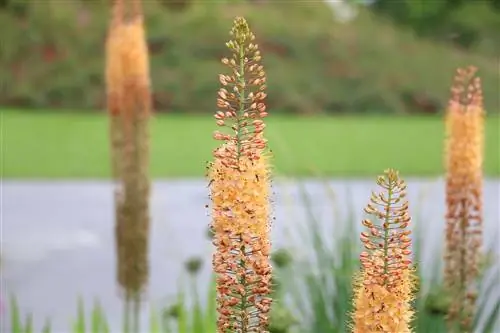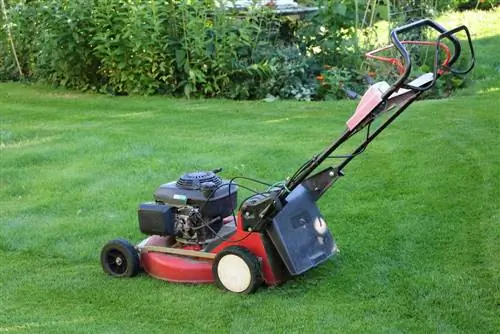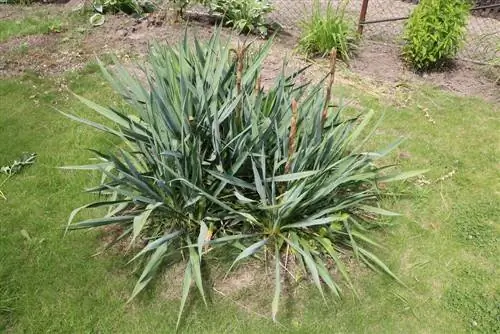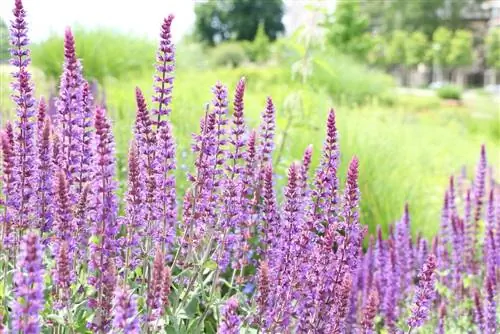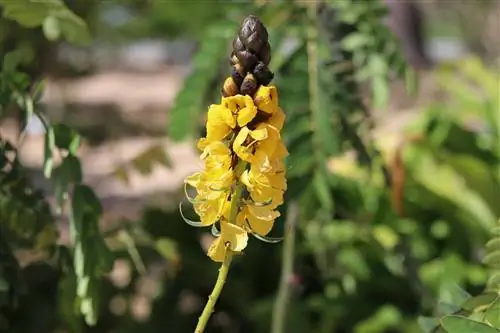- Author admin [email protected].
- Public 2023-12-17 03:39.
- Last modified 2025-06-01 06:48.
Creative garden design cannot do without dominant eye-catchers. The impressive steppe candle is perfect for this task. It proudly stretches up to the sky, as high as a man, and lends rural charm to herbaceous borders and hedgerows. Find out here about the right planting time, successful planting and successful care.
Steppe candle, Eremurus - planting time, plants and care
In a creative plant composition, magnificent solitaires such as the steppe candle should not be missing. With their powerful, man-sized appearance, they seem to take a majestic bath in the crowd, surrounded by decorative plant neighbors in the perennial bed. Eremurus are just as impressive against the dark backdrop of dense trees. They also exude rural charm in a classic cottage garden. If you are now curious about practical details about planting time, plants and care, you will find all the important information here.
Profile
- Plant family of the grass tree family (Xanthorrhoeaceae)
- Genus Steppe Candles (Eremurus)
- Perennial, herbaceous flowering perennial
- Native to the Asian plateaus up to 3,000 meters
- Growth height 80 to 250 cm
- White, pink or yellow flowers from May to July
- Hardy down to -18 °C
- Common names: steppe lily, lily tail, Cleopatra needle
More than 45 species live in this impressive genus. These provide the basis for the breeding of numerous hybrids that surprise with ever new color nuances.
Planting time
The window for planting opens in April and remains so throughout the summer. This circumstance allows creative hobby gardeners to flexibly design their planting plan. The best prospects for rapid growth are when the ground warms in May.
Location
So that the steppe candle can fully develop its majestic beauty, the location is chosen carefully. The flowering perennial should meet the following conditions:
- sunny location, preferably sheltered from the wind
- nutrient-rich soil, humus and deep
- fresh, preferably loamy-sandy, without the risk of waterlogging
- preferably calcareous with a pH value greater than 8
Of course, an adult Eremurus bravely braves many gusts of wind. In locations that are too exposed to wind, a support should be planned right from the start, for example in the form of a stable bamboo stick.
Plants
So that the tubers spread their roots quickly, the soil is professionally prepared before planting. All stones and roots are removed and all weeds are thoroughly weeded. The planting hole has twice the volume of the rootstock. At the bottom of the pit, drainage made of gravel, grit, sand or expanded clay effectively prevents the risk of waterlogging. The heavier and denser the clod, the deeper the drainage goes into the earth. The excavation is enriched with compost and horn shavings to ensure optimal starting conditions. If you now insert the young plant, the eye must not be deeper than 15 cm below the surface of the soil. After the steppe candle has been watered, a mulch layer of grass clippings, compost or horse manure protects the planting site from erosion, keeps the soil warm and constantly releases valuable nutrients.
Tip:
So that rough drainage material does not damage the tuber, a water and air-permeable piece of garden fleece is placed over it.
Watering and fertilizing
In terms of water and nutrient supply, the steppe candle does not make any special demands. As long as it is not exposed to permanent drought or waterlogging, it will thrive reliably for many years in the chosen location.
- water regularly with normal tap water
- the use of low-lime rainwater requires repeated liming
- the soil surface should dry between waterings
From April until the end of flowering, the Eremurus receives a dose of ripe compost mixed with horn shavings every 14 days. You can optionally apply a slow-release fertilizer in spring and summer. A portion of horse manure or stable manure now and then covers the fairly high nutrient requirements.
Cutting
The withered flower head is cut off in autumn if the perennial does not want to self-sow. It should be borne in mind that the seed heads look very ornamental at this time of year. Stems and leaves ideally remain until the first frost. Until then, the tuber will absorb all the nutrients it needs to prepare for the winter. At the same time, the Cleopatra needle is already building up an energy reserve for next year's budding.
Tip:
The foliage of a steppe candle slowly becomes unsightly early in the year. A clever arrangement of suitable plant partners hides the foliage so that the viewer only sees the beautiful flowers.
Wintering
Equipped with robust winter hardiness, the steppe candle basically does not require any special protective measures. Experienced hobby gardeners do not rely on this, but instead spread a thick layer of straw, brushwood, leaf mold or compost over the planting site in late autumn. This cover remains in place during early budding so that late frosts do not cause any damage.
Propagate
Division: The star-shaped rhizomes of an Eremurus are ideal for uncomplicated propagation by division. This is how it works:
- Carefully dig up the entire rootstock in August
- pay particular attention to the brittle root strands and the sensitive buds
- cut into two or more segments with the spade
The root pieces are inserted at the new location without long delay. Beforehand, the soil should be thoroughly loosened and cleaned. In the end, the buds should be about 15 to 20 cm underground, bedded on a drainage layer of sand or gravel.
Sowing
Propagation using seeds places somewhat higher demands on the hobby gardener's we alth of experience because it involves cold germination. Mother Nature protects late-blooming perennials from developing seedlings in the middle of winter with germination inhibition. In order to overcome this inhibition threshold, the seeds must be exposed to a cold stimulus lasting several weeks, which simulates the natural change of seasons. Smart leisure gardeners use their refrigerators for this purpose.
- Put the seeds with moist sand in a plastic bag and close tightly.
- Store in the vegetable compartment of the refrigerator for 4 to 6 weeks.
- Check regularly for moisture levels and look for cotyledons.
- Sort out seedlings immediately and place them in a nutrient-poor substrate.
During a transition period of one week, place the seedlings in a dark place at 12°C. Then place the cultivation containers on the warm, partially shaded windowsill. Here they are kept constantly moist while further pairs of leaves form. If a pot is completely rooted, plant the young steppe candles in commercially available potting soil. It is important to note that Eremurus always receive a sufficiently wide planter so that the star-like rhizome can spread unhindered. Once they reach a height of 30-40 cm, they are planted out in the bed.
Tip:
The steppe candle also looks good as a cut flower in the floor vase. Alone or in association with oriental poppy and bearded iris.
Conclusion
The steppe candle is a magnificent flowering perennial that stretches meters high into the sky. Like giant flares, Eremurus dominate in herbaceous borders, on the edge of the trees, while they bloom tirelessly from May to July. Even the autumn seed heads have a decorative effect. To enjoy this rural charm, little maintenance is required. The steppe candle should not dry out and should be fertilized regularly. The flower is flexible when it comes to the right planting time, as it can be planted all summer long. If you want the extravagant solitaires in several areas of the garden, simply propagate the steppe candle by dividing the rootstock.
Did you know? - Steppe candles form a new “starfish” every year. This produces the flowers the following year. That is why it is important that the foliage assimilates. This requires sun and plenty of nutrients. A thick layer of rotted or composted cow or horse manure is ideal for this.
Profile
- Flowering period: May to August with long, upright flower candles consisting of small flowers in yellow, pink, red, orange or white; blooms from below
- Foliage: strap-shaped blue-green leaves that die and shrink after flowering
- Growth: clump-like growth; fleshy roots spread out like a starfish
- Height: depending on the species and variety 80 to 200 cm
- Location: sunny, warm; nutrient-rich, deep, loose, dry soil; Cannot tolerate constant wetness
- Planting time: autumn; If the ground is solid, work in a 3-5 cm thick layer of sand beforehand; Plant roots 15-20 cm deep; Planting distance 6cm; Can also be sown from fresh seeds
- Pruning: remove dead leaves and flower spikes
- Partners: Perennials that cover the gap between the retracted leaves
- Propagation: Division after flowering or sow fresh seeds
- Care: water only when dry conditions persist; Add compost or slow-release fertilizer in spring
- Wintering: requires protection from winter moisture and frost
- Diseases/problems: Roots are very sensitive and start to rot easily if they are persistently wet; Roots are also brittle and break easily
Special features
- Also called Cleopatra's needle
- Good and durable cut flower
Species
- Lilytail (Eremurus bungei) - height 100 cm. Blooms bright yellow from June to August. Bulb circumference 9cm. It also copes well with partially shaded areas. Occurs naturally in West and Central Africa
- (Eremurus robustus) - height 220cm. Impresses with pink buds that bloom white
- (Eremurus x isabellinus) - height 200cm. Blooms in yellow, pink, orange, red or white
Varieties (selection)
- Cleopatra: height 120 cm; blooms in orange from May to July
- Perfecta: height 130 cm; blooms in bright yellow
- Ruiters hybrids: height 150-200 cm; Mixture of plants flowering from May to June in white, red, orange, yellow and pink
- Himalayan steppe candle (Eremurus himalaicus) - 100 to 250 cm high, white flowers, blooms in June, occurs in the Himalayas up to 3,600 m altitude
- Aitchison steppe candle (Eremurus aitchisonii) - 100 to 200 cm high, flowers pink with a yellow background, blooms in May, grows at altitudes between 1,000 to 3,000 m
- Bukhara steppe candle (Eremurus bucharicus) - 80 to 100 cm high, flowers pale pink with a dirty purple vein, blooms in June, likes fine soil
- Kaufmann's steppe candle (Eremurus kaufmannii) - 70 to 100 cm high, white flower and yellow base, flowering period from June to July, thrives on fine earth and gravel slopes
- Milk-white steppe candle (Eremurus lactiflorus) - 55 to 80 cm high, milk-white flowers with a yellow throat. Flowering time May, sometimes as early as April, likes stony mountain slopes
- Giant steppe candle (Eremurus robustus) - 100 to rarely 300 cm high, flowers light pink, yellow at the base, flowers in June, likes heights between 1,600 and 3,100 m
- Sightly steppe candle (Eremurus spectabilis) - 75 to 200 cm high, flowers pale yellow, often green, flowering period June/July, likes semi-deserts

